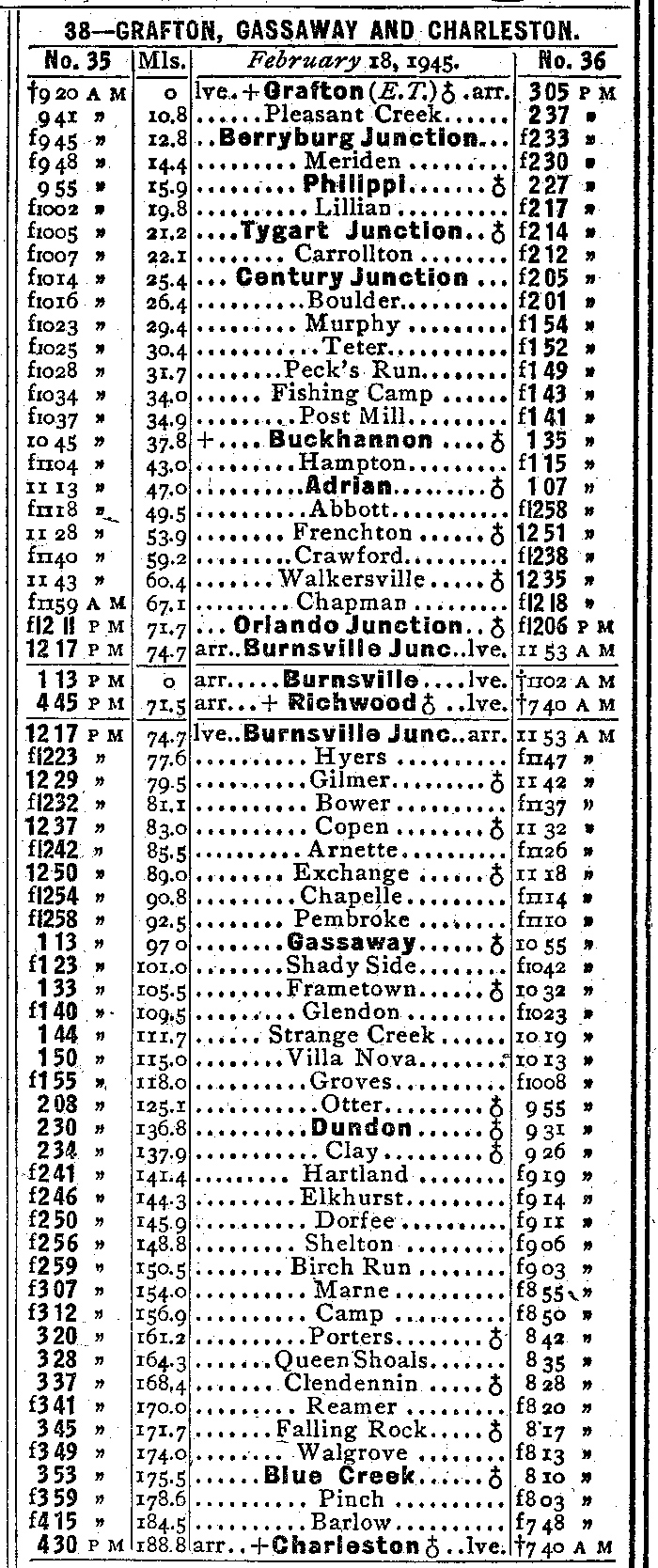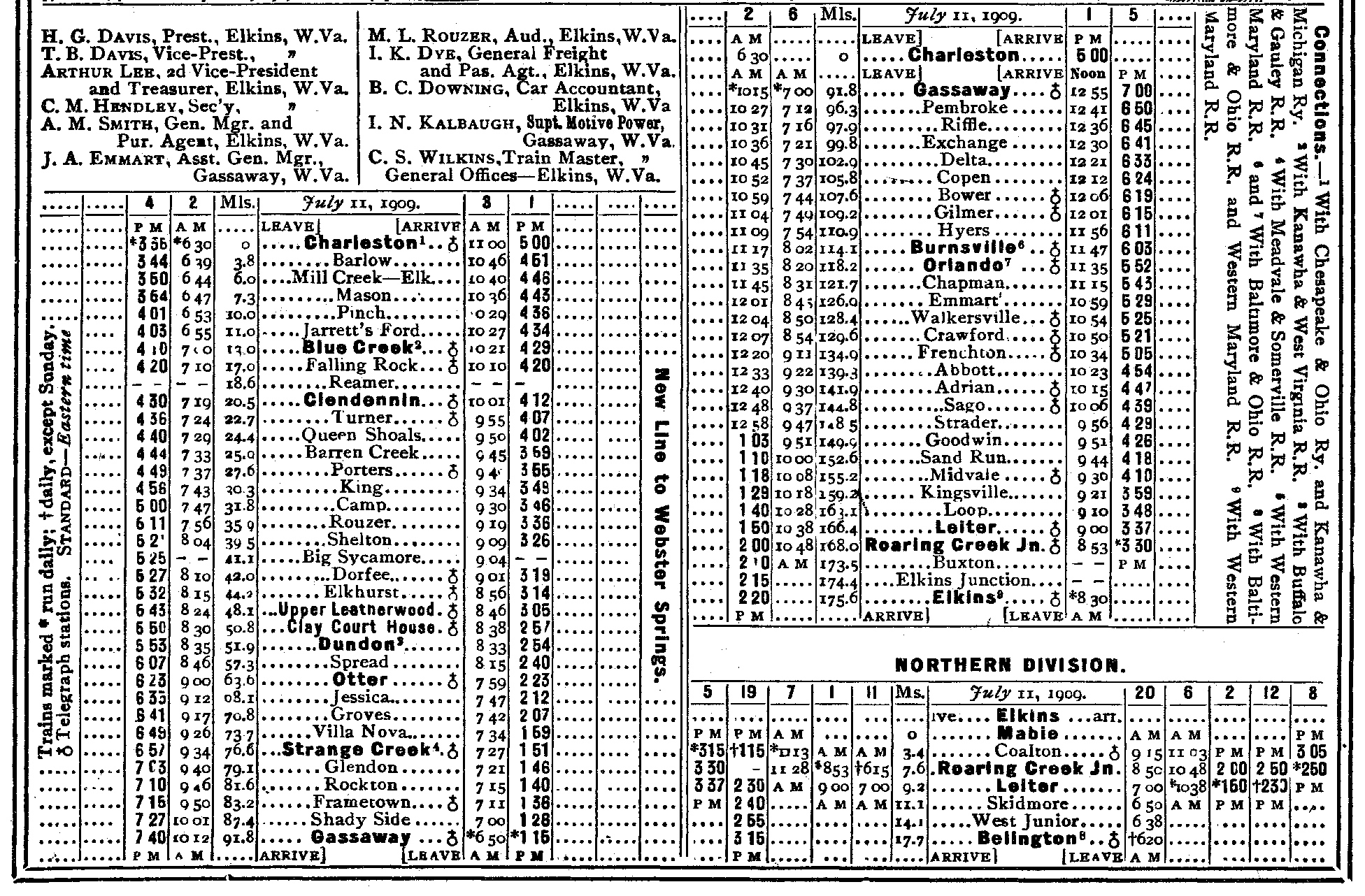Coal and Coke Railway: Map, Timetables, History
Published: February 11, 2025
By: Adam Burns
Chartered in 1902, the Coal and Coke Railway emerged as a critical transportation link for the burgeoning coalfields located in central West Virginia during the early 20th century.
The system was a brainchild of entrepreneur Henry Gassaway Davis, a prominent industrialist and politician, who envisioned creating a more efficient means of transporting the mineral - and timber - wealth out of the state. Following his passing the C&C was leased by the Baltimore & Ohio in 1916, which eventually fully acquired the 193.3 mile railroad in 1934.
Under the B&O the line was officially designated as the Charleston Division or Charleston Branch. However, to most enhtusiasts, and even crews, it was simply referred to as the Coal & Coke.
The B&O, which practically had a monopoly on rail service in Northern West Virginia, used the line to expand its coal operations while also enabling it to reach the state capital where it interchanged with the New York Central's former Kanawha & Michigan and Chesapeake & Ohio.
Various factors, such as the depletion of large-scale timber resources, a gradual downturn in the Mountain State coal industry, and the shutdown of a refinery at Falling Rock, saw the line closed in stages over 40 years.
The C&C was also notoriously difficult to operate due to numerous tunnels, sharp curves, and steep grades. By 1972, the B&O ceased operations on the line between Midvale and Roaring Creek Junction due to multiple mine closures.
Subsequent attempts by Chessie System, and later CSX, to abandon much of the line south of Gassaway were partially averted by interventions from Conrail, and later the Elk River Railroad during the mid-1990s.
The latter operation had hopes of not only handling significant coal traffic but also reestablishing the connection in Charleston.
However, the final closure of a mine on the Buffalo Creek Railroad near Dundon along the old Buffalo Creek & Gauley led to the remaining tracks south of Burnsville being used primarily for railcar storage at Gassaway, which ended in 2022.
Today, most of the route from Gassaway to Charleston has been converted into a linear state park intended for recreational activities while the old BC&G now offers tourists rail biking experiences.
System Map (1910)
The modern Coal & Coke Railway (C&C) was inaugurated on May 14, 1902, by former Senator Henry Gassaway Davis. Its primary intent was to establish a link between the Chesapeake & Ohio and the Kanawha & Michiga in Cnharleston with the West Virginia Central & Pittsburg (WVC&P) near Elkins.
Senator Davis had acquired substantial tracts of land in Randolph County's Roaring Creek area and neighboring counties, known for their abundant coal and virgin timber resources. The C&C was capitalized at $5 million.
In a strategic move to enable construction, Davis sold the WVC&P to distinguished railroad magnate George L. Gould in January 1902, which was folded into his Western Maryland Railway. The WM would utilize the line as a coal and timber traffic feeder as part of its Thomas Subdivision.
Following the sale, Davis purchased the Roaring Creek & Charleston Railroad (RC&C), linking Roaring Creek and Elkins, and Roaring Creek & Belington Railroad (RC&B), connecting its namesake points. The former joined the WVC&P at Elkins while the latter interchanged with both the B&O at Belington and WVC&P at Roaring Creek.
Gould, who was attempting to establish a true coast-to-coast transcontinental railroad, was trying to connect his Wabash-controlled operation from Pittsburgh to Cumberland and Baltimore via the Western Maryland. The WVC&P provided the WM with feeder traffic out of central West Virginia.
Construction of the Coal & Coke under Davis commenced on April 17, almost immediately after its formation. Given the topographic challenges, the C&C's construction was an engineering marvel of its time, involving numerous cuts through mountainous terrain, bridges over deep valleys, and tunnels through solid rock.
The line ultimately required 23 tunnels and 30 steel bridges from Norton to Gassaway and was notably devoid of wooden trestles or timber bridges. The Coal & Coke was formally completed on December 1, 1904 following the driving a final spike at Walkersville, completing the Charleston to Elkins route.
The railway spurred economic development in West Virginia's counties by providing jobs and increasing the demand for coal production, thereby attracting both skilled and unskilled labor from across the country. It facilitated the growth of several towns along its route, contributing to the socio-economic transformation of the region.
The Coal & Iron Railroad, an extension of the C&C, was completed earlier in 1903, extending from Elkins to Durbin near the headwaters of the Greenbrier River, where it interchanged with the C&O's Greenbrier Division.
This system was a subsidiary of the WVC&P and upon acquisition by the WM became an important component of the railroad, particularly in the movement of coal and timber.
Timetable (1910)
B&O Operations
On November 23, 1912, Mr. Davis retired from his role at the C&C at the age of 89. He passed away in 1916, concluding his leadership. At the time of his death, the C&C spanned 175.6 miles, with a notable 16-mile stretch connecting Belington to Norton, Mabie, and Coalton, and a 6.5-mile branch from Gassaway to Sutton.
The network also linked with the B&O at Belington, the WM at Roaring Creek Junction and Elkins, the Kanawha & Michigan at Charleston, and featured switching agreements with the C&O in Charleston. In 1916, the B&O leased the C&C, which then operated as the Coal & Coke Branch.
Aside from online traffic the B&O maintained an important connection with the Buffalo Creek & Gauley at Dundon. This short line, owned by the Elk River Coal & Lumber Company, generated substantial coal and timber from its 102,000 acres of property in Clay County.
Decline
The original C&C saw cutbacks as early as 1941 when the B&O abandoned the Adrian-Midvale segment and began utilizing trackage rights over the nearly parallel WM to continue serving customers in the Elkins area.
Coal traffic, which was the line's primary traffic source, declined precipitously during the 1950s although did see a brief surge when the B&O opened the Heathcliff Branch in 1959 to serve a new mine at Truebada. Unfortunately, despite peaking at 937,092 tons in 1964, output at this mine dropped steeply over the next few years and it closed in 1967. The branch was subsequently abandoned on December 16, 1971.
By the 1970s the Coal & Coke had devolved into an insignificant secondary corridor under then-Chessie System's network. By then it witnessed heavily deferred maintenance with minor new ballast, ties buried in the mud, and little weed control.
The railroad abandoned the 28.75 miles from Reamet to Hartland in 1979, followed by an additional 5 miles from Hartland to Dundon in 1985. By then, the BC&G had been shutdown since 1965 and the remaining Coal & Coke line was only serviced three-times per week.
Following CSX's creation in 1980 the railroad immediately began removing large segments of the B&O in Northern West Virginia, including 61 miles of the Coal & Coke from Gilmer to Hartland in 1987. This move was in part due to the closure of the line's sole remaining customer near Charleston, the Elk Refinery in 1983.
Conrail subsequently acquired the Charleston-Hartland section in 1985 to service at mine at Falling Rock, which subsequently closed in 1990.
B&O Timetable - Charleston Division

Elk River Railroad
The Gilmer-Hartland segment returned to service later in the 1990s under Bill Bright which launched the Elk River Railroad to service a mine on the former BC&G at Avoca.
Significant investments were made to upgrade 56 miles to meet FRA Class II standards, featuring new ballast and welded rail, enabling empty trains to reach speeds of 14 MPH and loaded trains 10 MPH.
On May 9, 1996, the first revenue operation occurred from the BCG at Avoca, where over 90 cars of coal were transferred via the ER to CSXT at Gassaway. Weekly unit coal trains transported coal to an American Electric Power plant (AEP).
The new operation was featured extensively in Trains Magazine from the March, 1998 issue in a piece by Both Withers entitled, "The Railroad That Refuses To Die."
In addition to this acquisition, the ER aimed to acquire an additional 29.8 miles of the former B&O from Hartland to Falling Rock, where it could connect to Conrail, and utlimately Charleston.
Unfortunately, operations abruptly ended when AEP discontinued purchasing coal from the mine in September 1999. Consequently, on November 15, 2001, a contract was established with Appalachian Railcar Service and the remaining line from Gassaway to Dundon was utilized for car storage while Gassaway Yard was repurposed for railcar repair and storage.
Today
In 2005, CSX leased its section from Gilmer to Burnsville to Watco, which subsequently transferred operations to the Appalachian & Ohio Railroad (A&O) in 2006.
In 2010, plans were proposed for the Charleston, Blue Creek & Sanderson Railroad to service a coal mine proposed along the former K&WV line on Blue Creek, which would be reactivated. Ultimately, this plan never materialized.
On May 5, 2019, the state of West Virginia acquired a 62-mile section of the Clendenin to Frametown from the Elk River to develop a new linear state park called the Elk River Trail. By August 2021, 37 miles of the trail had opened, stretching from Frametown to central Clay County, with plans to extend further to Clendenin by the fall.
Subsequently, the short line ceased operations in the winter of 2022, with the last group of stored cars removed from Gassaway Yard in March and the final train running between Gassaway and Gilmer on April 22.
Recent Articles
-
Massachusetts - Wine Tasting - Train Rides
Dec 26, 25 03:37 PM
This article dives into some of the alluring aspects of wine by rail in Massachusetts, currently offered by the Cape Cod Central Railroad. -
Maryland - Wine Tasting - Train Rides
Dec 26, 25 03:34 PM
This article delves into the enchanting world of wine tasting train experiences in Maryland, providing a detailed exploration of their offerings, history, and allure. -
Florida Thomas The Train Rides
Dec 26, 25 03:32 PM
Each year, Day Out With Thomas™ turns the Florida Railroad Museum in Parrish into a full-on family festival built around one big moment: stepping aboard a real train pulled by a life-size Thomas the T…





